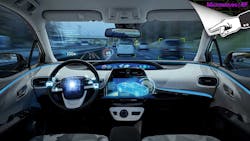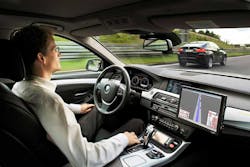How Smart is Too Smart? AVs Appear to Exhibit Sentient Behavior
Download the entire collection of April 1st articles in PDF format.
From April 1st, 2021 @Microwaves & RF
The 2021 model year marks the point where cars equipped with self-driving capabilities have moved beyond being a rare novelty to a small but growing fraction of the global rolling stock. While car makers are touting the many benefits of autonomous vehicles, some owners, such as Peter Fletcher, are also experiencing the technology's unintended consequences as their vehicles appear to be exhibiting sentient behavior (Fig. 1).
"The Tesla was sort of a retirement present to myself,” said Fletcher, a highly respected tech journalist based in Maidstone, England. "Naturally, I ordered it with, as they say, all the bells and whistles, including the advanced autopilot feature. The sales agent told me it was very smart, but I'm pretty sure he wasn't talking about the sort of stuff that's been happening for the past few weeks."
The phenomenon hasn’t been limited to Tesla. Reports of various types of sentient behavior, such as spontaneous platooning and showing deference to vehicles of the same brand, have been reported in other makes, including GM vehicles equipped with Super Cruise, Honda's limited production Legend, and some Hyundai/Kia models.
Park Replace
Fletcher said that the first incident took place about a week after he took delivery of his new Model 3 when he hopped into the car to run a few errands. "I put the car in drive, but it refused to budge from its parking space for nearly a minute," he said. "At first I thought I'd accidentally left the parking brake on or tripped some safety feature. But, after what seemed like forever, the car suddenly went into gear for no apparent reason and started easing out of my parking space. Since the traffic in Maidstone can be pretty bad, I kept a careful watch in the rearview and happened to note that, by an odd coincidence, another Tesla that had pulled up a moment earlier slid into the space I'd left."
Fletcher didn't think much more about the incident until a couple of days later when he was looking for a parking space himself in Maidstone's congested shopping district. "I'd spent quite a while looking for a space and was just about to give up when the car seemed to stall out, or that's what I told myself until I realized I was driving an EV."
While Fletcher struggled to determine what had caused the unexpected halt, he glanced up in time to see another Tesla pull out from the curb a few feet ahead of him and watch his car use its auto-park function to quickly fill the vacancy.
After the local Tesla dealer's service department told Fletcher that a full diagnostic test failed to reveal any abnormality, he turned to a Tesla owner's forum for answers. "There were only a handful of accounts of unexpected behavior, but they were enough to reassure me that I wasn't simply imagining things."
Following a hunch, Fletcher turned up a handful of similar accounts on owner's forums for other makes, including GM, Hyundai/Kia, and Mercedes, that described various types of unexpected, spontaneous actions their cars had undertaken without permission or warning. He also noticed that the reports began to appear on the forums only after model year 2021 vehicles hit the road, most notably those with the latest versions of the companies' most advanced autopilot options.
Several Hyundai/Kia owners reported that when their cars were on open stretches of highway, they would sometimes spontaneously form "platoons" with other cars of the same make (Fig. 2). Some owners of 2021 Mercedes with the Driver Assistance Package PLUS system also report finding themselves in an orderly formation of several other Mercedes, precisely spaced a few feet from the bumper ahead of them. Autonomous-vehicle research has shown that the slipstream created by these tight formations can significantly improve fuel economy, but the feature isn't available in any production vehicle yet.
Is This Sentient Behavior?
Although it's too soon to draw conclusions, the spontaneous behavior exhibited by these cars may be a sign of some sort simple emergent sentience, according to Dr. John Yaya, an artificial-intelligence researcher at YoYo Dyne Systems, Grovers Mill, N.J. "The GPUs they use in these advanced systems contain billions of logic gates, creating a level of complexity that's close to, or at the threshold for, exhibiting various types of emergent behavior. And when you combine in the non-deterministic nature of GPU processors and the self-learning algorithms that many of these systems to fine-tune their software, I'm almost surprised that we aren't getting more reports of cars starting to think for themselves."
Fletcher's preliminary research seems to concur with Dr. Yaya's theory. All discussions related to spontaneous vehicular activities he could find on the users' groups indicates that it appears to occur only in systems operating at the higher range of the Level 3 autonomy scale. This is where self-learning begins to become necessary for the car to adapt to new and unknown environments.
With only a few exceptions, these unique behaviors appear to be limited to interactions between vehicles that were manufactured by the same company, although the cars seem to cooperate equally well with other models in their brand. The one situation where what one might call "inter-species cooperation" occurs is when an electric car is subjected to harassment or aggressive driving by drivers who for one reason or another hate EVs.
Coal Rolling Leads to Pack Hunting
The most common type of harassment is "coal rolling." The tactic is practiced by diesel truck owners, who deliberately re-tune their engines to increase fuel-air ratio in order to emit large amounts of black or grey sooty exhaust fumes into the air when they depress the accelerator. While this practice was originally a way to protest environmental regulations, it's now commonly used to harass Teslas, Priuses, and other "eco-vehicles" by unleashing clouds of smoke in their path. Some drivers also report coal-rolling incidents that have been accompanied by more aggressive actions, including being forced off the road, sometimes at high speeds.
EVs, hybrids, and other green vehicles have become targets for radical anti-environmentalists, but the cars are beginning to defend themselves. (Credit: InsideEVs.com)
For the most part, the cars equipped with advanced safety features were able to evade the worst of these attacks (see the video above). In the last six months, though, some autopilot-equipped cars seem to be taking things a step further by coming to the aid of other EVs and hybrids under attack—regardless of their brand. During these interventions, referred to as "pack hunting" in the user forums, cars that are close enough to come to the aid of the one under attack will swarm the aggressor vehicle and either force it to the shoulder of the road or bring it to a dead halt within whatever lane it's in.
The first incidents of pack-hunting behavior were reported in the fall of 2020 and appeared to be confined to Tesla vehicles. This changed in late January when reports of other brands of cars joining in on the hunts began to emerge.
"It's almost as if the other brands learned the tactics from the Teslas," said Yaya. "The way they collaborate is very impressive, but we're still not sure exactly how they do it. I hope we'll be able take a look at the algorithms their self-learning software has generated. It would probably give us valuable insights on some other tough problems we're working on. But then again, I'll have to be very careful when I try to pick their brains—it could be a very bad thing if I made them angry."
None of the car makers mentioned in this story were available for comment.
Read more at April 1st, 2021 @Microwaves & RF
About the Author
Lee Goldberg
Contributing Editor
Lee Goldberg is a self-identified “Recovering Engineer,” Maker/Hacker, Green-Tech Maven, Aviator, Gadfly, and Geek Dad. He spent the first 18 years of his career helping design microprocessors, embedded systems, renewable energy applications, and the occasional interplanetary spacecraft. After trading his ‘scope and soldering iron for a keyboard and a second career as a tech journalist, he’s spent the next two decades at several print and online engineering publications.
Lee’s current focus is power electronics, especially the technologies involved with energy efficiency, energy management, and renewable energy. This dovetails with his coverage of sustainable technologies and various environmental and social issues within the engineering community that he began in 1996. Lee also covers 3D printers, open-source hardware, and other Maker/Hacker technologies.
Lee holds a BSEE in Electrical Engineering from Thomas Edison College, and participated in a colloquium on technology, society, and the environment at Goddard College’s Institute for Social Ecology. His book, “Green Electronics/Green Bottom Line - A Commonsense Guide To Environmentally Responsible Engineering and Management,” was published by Newnes Press.
Lee, his wife Catherine, and his daughter Anwyn currently reside in the outskirts of Princeton N.J., where they masquerade as a typical suburban family.


